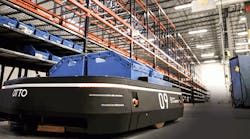A swarm of robots are overtaking John Deere's Horicon, Wis., plant.
Sometime this year, a fleet of new-generation automated guided vehicles (AGVs) are scheduled to begin zipping through the lanes of the company's assembly line, hauling parts and materials across the plant in an efficient, automated buzz.
On the face of it, there is nothing too exciting about this news. AGVs are nothing new to the market; they have been scurrying around plants in one form or another for decades already.
But none of them has ever been quite like these.
John Deere's fleet will mark the latest deployment of OTTO 1500 —a fully self-driving, autonomous robotic vehicle built by a new player in the space, Kitchener, Ont., Canada-based Clearpath Robotics.
The machines are capable of transporting up to 3,000 pounds of goods through congested plant and warehouse environments without the need for drivers, supervision, or guidance infrastructure.
That last detail is what makes this technology exciting.
Traditional AGVs require a lot of work and a lot of free space to run safely and efficiently. In the past, this has meant tying them to magnetic strips or grids of barcodes crisscrossing human-free transport lanes.
But not anymore.
According to Clearpath co-founder and CEO Matt Rendall, OTTO taps into the same sensor-driven, high-computing backbone that Google uses in its self-driving car to safely and efficiently transport supplies along the same plant and warehouse paths populated by workers and equipment.
"The key difference between OTTO and previous generations of this technology is that fundamentally OTTO is off the track," explains Rendall.
He likens the distinction to the difference between subway systems and taxis in a busy city.
"There is a time and a place for a subway system," he says. "But when speed and efficiency are needed, there is also a time and a place for taxi cabs."
However, creating a robot smart enough to safely traverse a busy plant is a far cry from trusting an experienced driver to get you to the office on time. To make that jump, Clearpath had to tap into the full arsenal of today's technological tools.
A High-Tech Backbone
The biggest story in the AGV market in recent years was Amazon's 2012 purchase of Kiva Systems.
The $775 million deal gave Amazon exclusive access to Kiva's line of warehousing robotics—at the time considered to be one of the most advanced in the market—with the online retailer eventually deploying 15,000 of them to streamline, upset, and in all ways redefine its complex order picking and delivery process.
According to Rendall, Kiva's extremely efficient system was years ahead of its time when it was conceived and built 13 years ago. However, he notes, the technological tools at the disposal of contemporary robot makers have changed dramatically since then.
"Vehicles like these require 2-D barcodes on the floor at approximately three-foot intervals," he explains. "So if you wanted to enable 100,000 sq. ft. of fulfillment, you would also need to deploy 100,000 sq. ft. of barcodes."
On top of that, he adds, those systems aren't safe for collaboration with humans. Together, this means the systems require a lot of unpopulated space and a lot of infrastructure to even get started.
The sweet spot of that generation of device, Rendall says, is in greenfield spaces—brand new warehouses and facilities that can be custom-built with the space and infrastructure they require. However, that is not a luxury most would-be users can afford. More to the point, it is no longer necessary.
"The technology landscape has fundamentally changed in the last 13 years," Rendall argues. "Smartphones, the Internet, cloud computing, the Internet of Things—these are all of the enabling pillars that come together in this beautiful way to make self-driving vehicles possible for manufacturing and for warehousing."
Computational power alone, he says, has increased exponentially in this time.
"It all starts with computation. We're able to build a vehicle that has much more powerful machine computation ability than you could have done 10 years ago, 13 years ago, for the same price," he explains. "That means you're able to do much more intensive algorithms onboard the robot."
And that's the key to the self-driving puzzle: the robot is smart enough to make critical decisions itself. Thanks to the high-tech backing it inherited from Google and the consumer technology industry, OTTO carries with it all of the sensors, computers, and internal logic capabilities to effectively plot courses, avoid obstacles, and safely interact with human coworkers in a way no other AGV has ever mastered.
By going off the track and off the barcode grid, it is able to access whole new aspects of the manufacturing process.
"When you remove those barcodes, you enable the ability to operate in close proximity to humans," Rendall explains. "This means you can not only do brownfield fulfillment, you can also do brownfield manufacturing. You can get deeper into the warehouse, or deeper into the factory than ever before."
Travis Hessman is editor-in-chief of MH&L's sister publication, New Equipment Digest.
---------------------------------------
Robots on the Roll throughout DCs
Clearpath is by no means the only tech company developing warehouse robots. Here are capsule descriptions of some other companies and their distribution applications.
• Fetch Robotics, a Silicon Valley-based start-up, has introduced a robotics system comprised of a mobile base (called Freight) and an advanced mobile manipulator (called Fetch). The robots are designed to work autonomously alongside workers, performing repetitive tasks such as warehouse delivery and pick and pack. Fetch and Freight used in tandem are said to be capable of handling the majority of all items in a typical warehouse.
• inVia Robotics, based in southern California, has introduced a "goods-to-box" robotics system, which is designed to integrate seamlessly with WMS and ERP solutions. The solution is available through a Robotics as a Service business model where users pay monthly for each robot, which allows them to scale up or down to meet seasonal or fluctuating demand. The company's GrabIt robot can lift items up to 30 lbs. and up to 24 inches wide, ranging in size from a deck of cards to a 24-pack of soda. It can also reach up to eight feet and work for 10 hours on a single battery charge. Once a product is picked, a GrabIt can offload an item to its companion, TransIt, which can accumulate orders and zip them to an awaiting box to be shipped.
• Locus Robotics, a Massachusetts- based start-up, has developed warehouse robots called LocusBots, and has deployed a multi-robot system at the fulfillment facility of its development partner, Quiet Logistics. According to Clint Reiser, an analyst with ARC Advisory Group, "The robots and warehouse associates work together in a manner designed to reduce travel time and increase productivity by utilizing a novel work process. Associates scan items and place into totes transported by the robots. The robots autonomously navigate through the warehouse infrastructure along with others in the fleet, guided by the Locus server."
• Vecna Technologies, based in Massachusetts, offers a fleet of robots with payloads from 5 kg to 2,000 kg, all of which can operate autonomously. The company offers an "autonomy kit" designed to automatically receive prioritized work requests from a user's WMS or MES, allowing the robots to operate as a team alongside their human counterparts.
This article originally appeared on Material Handling & Logistics, a companion site of IndustryWeek and part of Penton's Manufacturing & Supply Chain group.




